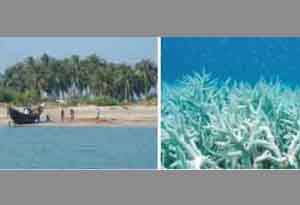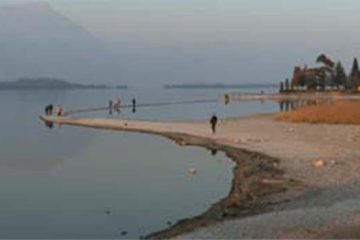Global Warming and Over-Exploitation
Corals of St.Martin’s at stake
Dr. Anisuzzaman Khan
 Honey comb corals around Saint Martin’s island are under stress due to coral bleaching. While the COP 17 — UN climate convention — was being held in Durban of South Africa, a Nature Watch Team (NWT) of Ekattor Television watched that a noticeable coral bleaching was defacing the corals of Saint Martin’s island of Bangladesh due to global warming. A four-member Scuba diving team moved under water around Saint Martin’s during the last week of December, 2011. They observed that the honey comb corals on the east coast of the island are severely affected by the bleaching. In addition, the team also identified corals are getting blanketed by sediments and thus failing to perform their natural physiological activities as a result of over plying of large tourist ships/ferries in the area.
Honey comb corals around Saint Martin’s island are under stress due to coral bleaching. While the COP 17 — UN climate convention — was being held in Durban of South Africa, a Nature Watch Team (NWT) of Ekattor Television watched that a noticeable coral bleaching was defacing the corals of Saint Martin’s island of Bangladesh due to global warming. A four-member Scuba diving team moved under water around Saint Martin’s during the last week of December, 2011. They observed that the honey comb corals on the east coast of the island are severely affected by the bleaching. In addition, the team also identified corals are getting blanketed by sediments and thus failing to perform their natural physiological activities as a result of over plying of large tourist ships/ferries in the area.
Although the government has formulated NAPA and BCCSAP and implementing programmes to combat the climate change impacts through adaptation, mitigation and DRR but to address the stress minimisation on huge marine resources underwater is not given adequate attention.
When corals lose their colour, it is known as “coral bleaching”. Coral bleaching became an issue when it was first observed on coral reefs in the South Pacific in the 1990’s. Coral bleaching is a stress condition in reef corals that involves a breakdown of the symbiotic relationship between corals and unicellular algae (zooxanthellae). These microscopic plants live within the coral tissue and provide the coral with food for growth and their normal healthy colour. The symptoms of bleaching include a gradual loss of colour as zooxanthellae are expelled from the coral tissue, sometimes leaving corals bone white.
IPCC study revealed that under stress, corals may expel their zooxanthellae, which leads to a lighter or completely white appearance, hence the term “bleached”. Coral bleaching is a generalised stress response of corals and can be caused by a number of biotic and abiotic factors, including:
-increased (most commonly), or reduced water temperatures
-increased solar irradiance (photosynthetically active radiation and ultraviolet band light)
-hanges in water chemistry (in particular acidification)
-increased sedimentation (due to silt runoff)
-bacterial infections
-changes in salinity
-herbicides
-low tide and exposure
-cyanide fishing
While most of these triggers may result in localised bleaching events (tens to hundreds of kilometers), mass coral bleaching events occur at a regional or global scale and are triggered by periods of elevated thermal stress resulting from increased sea surface temperatures.
Infectious bacteria of the species Vibrio shiloi are the bleaching agents of Oculina patagonica in the sea, causing this effect by attacking the zooxanthellae. The stress factor most commonly associated with bleaching is elevated sea temperature, but additional stresses such as high light intensity, low salinity and pollutants are known to exacerbate coral bleaching. If the causal stress is too great or for too long, corals can die.
Reef corals are very sensitive to sea temperatures outside their normal range. Elevated temperatures of 10 C above the long term monthly summer average are enough to cause coral bleaching in many dominant coral species. Global warming causes coral bleaching and there is absolutely no doubt about it. The heat affects the tiny algae which live symbiotically inside the corals and supply them with food. The heat stress damages the algae and in consequence leads to coral death. The argument for the global warming/coral bleaching connection was bolstered by the massive El Niño event in 1997 and 1998 that led to unusually warm tropical waters throughout the world’s lower latitudes and coral bleaching in many locations.
The physiological consequences of bleaching to the coral can be severe and lead to mortality, with subsequent ecological consequences to the coral reef ecosystem due to the key role of corals in maintaining ecosystem structure and function.
The ecological impacts of mass coral bleaching have been demonstrated to be severe, with massive losses in coral cover and diversity, as well as in other coral reef-associated organisms.
Economic losses to reef-dependent tourism are the most significant observed thus far. However, the potential sufferer for serious socioeconomic impacts are reef-dependent fishing communities as degraded reefs continue to erode.
Effective responses to mass coral bleaching are hampered by scientific uncertainty, our inability to respond to global climate change in the short term, and insufficient financial and human resources. However, these challenges cannot justify inaction. Rather they underscore the primacy of developing adaptive strategies and capacity so that countries and communities are prepared for future mass bleaching events. Mass bleaching is one of such stresses that necessitates identifying and planning for the expected ecological and socioeconomic impacts from future events. Effectively implementing adaptive management will require support from both the research and policy communities to provide the technical information and financial and human resources needed for success.
The policy community faces two great challenges. First, to commit the resources needed for successful implementation of coral reef management in the developing nations that play host to most of the world’s coral reefs. Second, to address global climate change through reduction in CO2 emissions.
Mass bleaching creates a broad constituency and justifies efforts to address global warming, as it foreshadows the potentially larger impacts to come about through unabated global warming. The NWT has suggested that an immediate monitoring programme is required to learn the causes and status of bleaching. Special attention is also needed to know the dumping impact of the untreated sewage and other waste materials from hotels, ships and others sources of Saint Martin’s island. It is also important to assess the carrying capacity of the tourism of the island.
St.Martin’s island with more than 700 species of biological diversity is an ECA and country’s first Marine Protected Area (MPA). To save these precious marine renewable natural resources from the onslaught of global warming and other human-induced changes an urgent monitoring programme is required. The present environment-unfriendly structures and activities should be relocated to nearby Sahpuri island instead of Saint Martin’s island.
(Article originally published on The Daily Star)
The writer is a biologist.



